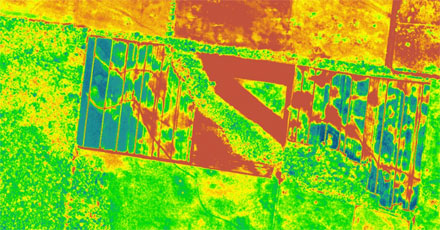Advances in spectroscopy imaging will be applied to the development of a hyperspectral/ultraspectral imaging system that will be used for remote sensing.
The imaging system incorporates a novel camera system that uses a compressive sensing technology. The camera, which has been significantly miniaturized, requires only one-tenth of the data traditionally needed to quickly produce high-resolution images.

An example of hyperspectral imaging for agricultural use. Courtesy of Ben-Gurion University of the Negev.
The camera system is based on the work of researchers at Ben-Gurion
University of the Negev (BGU). The BGU team will collaborate with
ImageSat International (ISI) to develop a high-performance,
high-resolution imaging system that is compact, simple to operate and
cost-efficient.
Remote sensing from space or aircraft has a wide range of applications including agriculture, climate and pollution monitoring, homeland security and commodity exploration.
"This new technology based on BGU research could lead to a new generation of spectral systems for flight- and space-based remote sensing," said professor Dan Blumberg. "The collaboration between academia and industry is a sterling example of the 'NewSpace' concept, which promotes innovation and creativity in the space industry and will enable ImageSat to become the leader in the field of hyperspectral imaging."
Hyperspectral imaging sensors measure the light reflected by the earth's surface in different wavelengths, ranging from one to several hundred per pixel. This generates significant amounts of data that must be transmitted to the earth for processing, and can require enormous bandwidth.